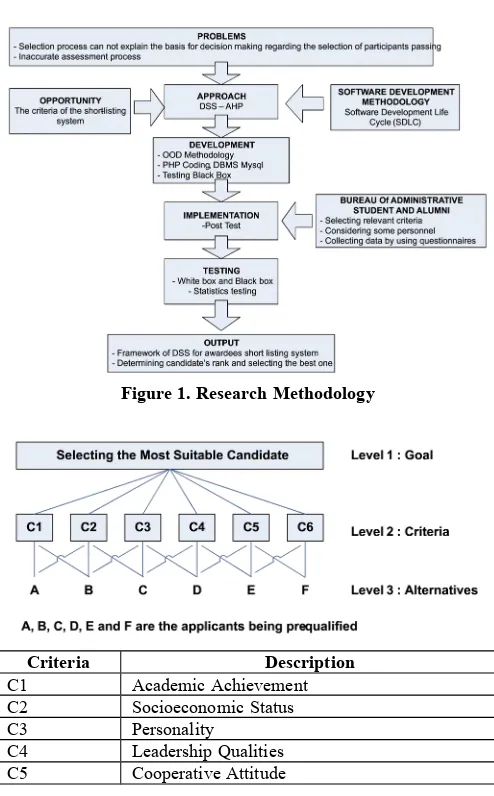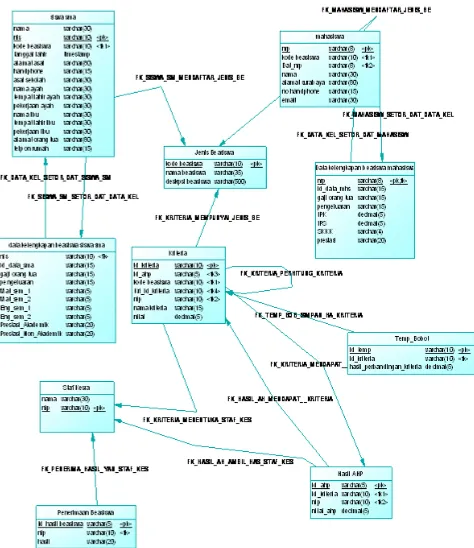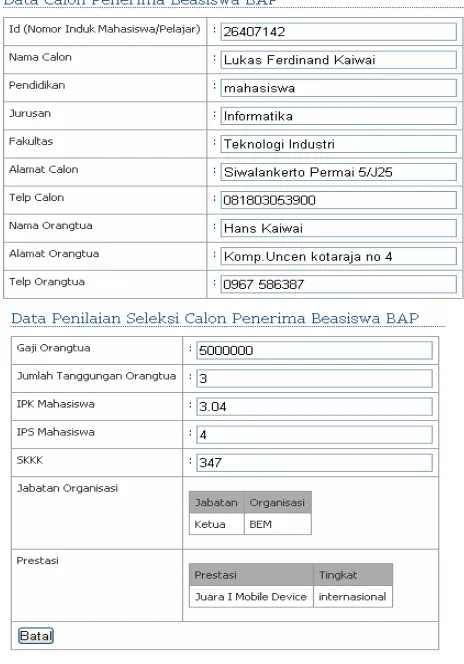Application of Multi Criteria Decision Making for an Online
organization, for example personnel recruitment, supplier selection, and awardees short listing system. The selection process in the area of awarding scholarships often uses a manual process which examines the candidate’s qualifications according to that specified by the scholarship scheme. The main objective of this research is to reduce the inefficiencies within the process and improving the quality of the final decision by minimizing the degree of personal preference. In this research, Analytical Hierarchy Process (AHP) has been implemented in awardees short listing system at Petra Christian University. Based on these needs, required a system that can provide considerations determine the decision of the scholarship recipients. Such systems provide objective results based on the terms and conditions have been determined by comparing the value of each scholarship recipients. So the result is in accordance with input provided by potential recipients.Keywords
Analytical Hierarchy Process, Scholarship, Systems Decision Making.
1.
INTRODUCTION
Petra Christian University Surabaya is one of the oldest private universities in Surabaya. By continually improving the quality of education, Petra Christian University continues to improve services and facilities that support academic atmosphere, such as by providing scholarships for students. A scholarship is an award of financial aid for a student to further their education. Scholarships are awarded on various criteria, which usually reflect the values and purposes of the donor or founder of the award. The types of scholarships are: merit-based scholarship, need-based scholarship, and student specific scholarship.
Scholarships are offered not only for undergraduate students, but for prospective students as well. In the awardees short listing system, Petra Christian University requires an application that can assist in determining priorities which candidate will receive a scholarship, so that decisions can be made efficiently. It requires a method that can assist in determining priorities so as to assist in decision making.
One method of decision making that can be used in the selection process of scholarship recipients is the method of Analytical Hierarchy Process (AHP). AHP is a systematic method and the appropriate selection using the method of decision-making based on a systematic analysis of the data.
The purpose of this research is to develop an awardees short listing application to support decision making in the selection of candidates for scholarship recipients using AHP in accordance with criteria set by Petra Christian University Surabaya.
The remaining part of this paper is organized as follows. Section 2 presents an overview of current proposal for dealing with analytical hierarchy process. Section 3 presents the methodology of this research and the approach that we have delineated to solve the proposed problems. Section 4 discusses the performance of proposed methods. Finally, section 5 concludes the paper.
2.
ANALYTICAL HIERARCHY
PROCESS
AHP is one of new approach to solve Multi-Criteria Decision Making (MCDM) problem which reduces complicated criteria to a series of pair wise comparisons and synthesizes the results [1, 2, 3]. One of the real world problems which could be encountered by MCDM is the recruitment and selection processes in human resources department. AHP have been implemented extensively in the recruitment and selection of human resources. Kaka [4], Katsumura [5], Melon [6] and Dolan [7] implemented AHP in the area of pricing system selection, cancer screening option, educational project evaluation, and patient preferences respectively.
AHP can be combined with other technique, like fuzzy system. This combination could solve problems in supplier selection [8], maintenance decision [9], organizational performance [10], and human resource evaluation [11].
AHP was chosen for this study based on the following reasons:
The ability of AHP to incorporate tangible and intangible factors in a systematic way.
It can solve constructed problems in a variety of decision making situation, ranging from the simple personal decisions to the complex capital intensive decision. The problem is broken down in a logical fashion from the
large elements to smaller elements.
It works by examining judgments made by decision makers and measure the consistently of those judgments.
AHP define the frameworks with a hierarchy of objective. It helps the user to achieve the goal from the attributes of problems, by decompose into a hierarchy. A hierarchy is a three-like structure that represents a complex problem on a number of levels [2]. The hierarchy develop consists of several levels. The top level represents the goal or the objective in terms of a problem statement. At the next level, the major criteria are defined is broad terms. Each criterion may be broken down to smaller level or individual parameter depending on the how many details are called in the model. The bottom level of the hierarchy contains the actual condition of the alternatives which under laying the problem.
relative importance of the element with respect to elements at the higher level in the hierarchy using pairwise comparison. In the AHP pairwise comparison a nine-point scale. (1-9) ratio be used to quantify the decision make’s strength of feeling between any two alternatives with respect to given criterion.
In the pairwise comparison a matrix is the preferred form. In general, if ‘n’ (elements) are being compared for given set of matrix, a total of n(n-1)/2 judgments are necessary to fill in the matrix. Saaty (1995) describes pairwise comparison on matrix as the element that appears in the left hand column is always compared with the element appearing in the top row, and the value is given to the element in the column as it compared with the element in the row. The next process is synthesis.
Synthesis is a process to complete the relative weights of the elements with regard to an element on the next level. This process must be performed for all matrix developed in the pairwise comparison, by using normalized eigenvector associated with the longest eigenvalue of their comparison matrix.
One of the advantages of the AHP is that it provides consistency checking of judgments call consistency Index (CI). Consistency is the intensities of relations among ideas or objects based on a particular criterion justify each other in same logical way. To add perspective, the consistency index can be verified in terms of inconsistency ratio (IR). Experience suggest that the CR or IR value should be between 0 and 0.10 or within ten percents of what would be the outcome from random judgments is acceptable [2].
3.
METHODOLOGY
In this part, research methodology will be described. The methodology involves using selected tools and techniques. There are Microsoft Project 2007 to manage the project, Power Designer 6.0 as a CASE tool, PHP as a programming language and Mysql as a database management system. All these tools are very important to ensure the project is carried out smoothly. Figure 1 presents research methodology.
The framework is developed through System Development Life Cycle (SDLC) methodology. The first step is investigation and planning phase. Literature review and knowledge acquisition are done. In this research, literature review is focus on two main topics, “selection criteria” and “AHP”. By conducting questionnaires survey and semi-structured interviews, expert knowledge captured. Figure 2 presents criteria for awardees short listing.
Figure 1. Research Methodology
Criteria Description
C1 Academic Achievement C2 Socioeconomic Status C3 Personality
C4 Leadership Qualities C5 Cooperative Attitude
Figure 2. Awardees Short Listing System and Criteria
In this research, context diagram and data flow diagram (DFD) are used for modeling processes, while Entity Relationship Diagram (ERD) is used to define the data storage for the system. Figure 3 shows system context and data flow diagram of the system. Figure 4 shows entity relationship diagram of the system.
Requirement for Scholarship Awardees for Future Students
Requirements for Scholarship Awardees
Candidate Scholarship Criteria
0 Awardees Shortlisting
System High School
Student Undergraduate
Student
Welfare Department
Application software is developed through process analysis, design, coding, whereby the software will be able to support the implementation of business processes of an organization, such as management of applicants, testing, and supporting decision for awardees short listing system.
Figure 4. Entity Relationship Diagram
The main sub-system of the proposed application is developing AHP. The design of the AHP must satisfy the goal of developing model that allowed the management to decide which candidate to be selected from the list of qualified candidate, the problems in the bureau of administrative student and alumni (BAKA/Biro Administrasi Kemahasiswaan dan Alumni) are numerous and the interrelationships among the criteria are extremely complicated. In any model development of AHP, the users needs to identify the goals of the research and the problem faced in order to achieve the goals [2].
The procedure for using the AHP can be summarized as [3] 1. Model the problem as a hierarchy containing the decision
goal, the alternatives for reaching it, and the criteria for evaluating the alternatives. Fig. 2 shows the criteria which used by the system.
2. Establish priorities among the elements of the hierarchy by making a series of judgments based on pairwise comparisons of the elements. Table 1 shows scale of pairwise comparison. The table is used to compare each criterion with each other criterion, one-by-one.
3. Synthesize these judgments to yield a set of overall priorities for the hierarchy.
4. Check the consistency of the judgments. Experience suggest that the consistency ratio (CR) or inconsistency ratio (IR) value should be between 0 and 0.10 or within ten percents of
what would be the outcome from random judgments is acceptable [2].
5. Get a final decision based on the results of this process.
4.
DISCUSSION
This part described in detail the testing process for the application that has been implemented. Tests performed on each menu as a whole, with the aim to be seen whether the program runs well. Figure 5 shows the main page of the application.
Figure 5. Screen Capture of Main Page
Figure 6. Screen Capture of Entry Page of Applicant
Figure 7. Screen Capture of Criteria for Selection Model
Figure 8. Screen Capture of Comparison Form
This program can be used to conduct an assessment of existing candidate within the organization. The system will process the score of each criteria based on the results of the criteria multiplied by the value of the sub-criteria. The expectation is if there are applicants who are less fit, it is advisable to be transferred to another position. The results of the implementation of the system can be seen in Figure 9 with the results that have been sorted by the highest score of an applicant.
Figure 9. Screen Capture of Final Candidates
5.
CONCLUSIONS
In this paper, AHP approach for awardees short listing system was presented. The method was applied using data from a real case in the educational industries. This application will generate the output score of candidates, so that applicants who have the highest score will have a great opportunity to be awarded a scholarship in the educational industry.
For the future research, considering the fuzziness of executives’ judgment during the decision-making process is crucial. By using fuzzy theory, it can be implemented to reduce uncertainty condition.
6.
REFERENCES
[1] Vaidya, O.S. and Kumar, S. 2006. Analytic hierarchy process: an overview of applications. European Journal of Operation Research, vol. 169, 1-29.
[2] Saaty, T.L. 1980. The Analytic Hierarchy Process, McGraw-Hill International, New York.
[3] Saaty, T.L. 2008. Decision Making for Leaders: The Analytic Hierarchy Process for Decisions in a Complex World. Pittsburgh, Pennsylvania: RWS Publications.
[4] Kaka, A., Wong, C., Fortune, C., and Langford, D. 2008. Culture change through the use of appropriate pricing systems, Engineering, Construction and Architectural Management, vol. 15(1), 66-77.
[5] Katsumura, Y., Yasunaga, H., Imamura, T., Ohe, K., and Oyama, H. 2008. Relationship between risk information on total colonoscopy and patient preferences for colorectal
cancer screening options: Analysis using the Analytic Hierarchy Process, BMC Health Services Research, vol. 8, 106.
[6] Melon, M., Beltran, P., and Cruz , M. 2008. An AHP-based evaluation procedure for Innovative Educational Projects: a face-to-face vs. computer-mediated case study, Omega, vol. 36(5), 754-765(12).
[7] Dolan, J. and Iadarola, S. 2008. Risk communication formats for low probability events: an exploratory study of patient preferences, BMC Medical Informatics and Decision Making, vol. 8(14), pp. 14, April 2008.
[8] Bottani, E. and Rizzi, A. 2008. An adapted multi-criteria approach to suppliers and products selection-An application oriented to lead-time reduction, Int. J. Production Economics, vol. III, 763-781.
[9] Cascales, M. and Lamata, M. 2008. Fuzzy Analytical Hierarchy Process in Maintenance Problem, IEA/AIE, LNAI 5027, 815-824.
[10] Wu, C., Chang, C., and Lin, H. 2008. FAHP Sensitivity Analysis for Measurement Nonprofit Organizational Performance, Quality & Quantity, vol. 42, 283-302, 2008.
[11] Genevois, M. and Albayrak, Y. 2008. A fuzzy multiattribute decision making model to evaluate human resource flexibility problem, Journal of Multiple-Valued Logic and Soft Computing, vol. 14(3) (5), 495-509.


